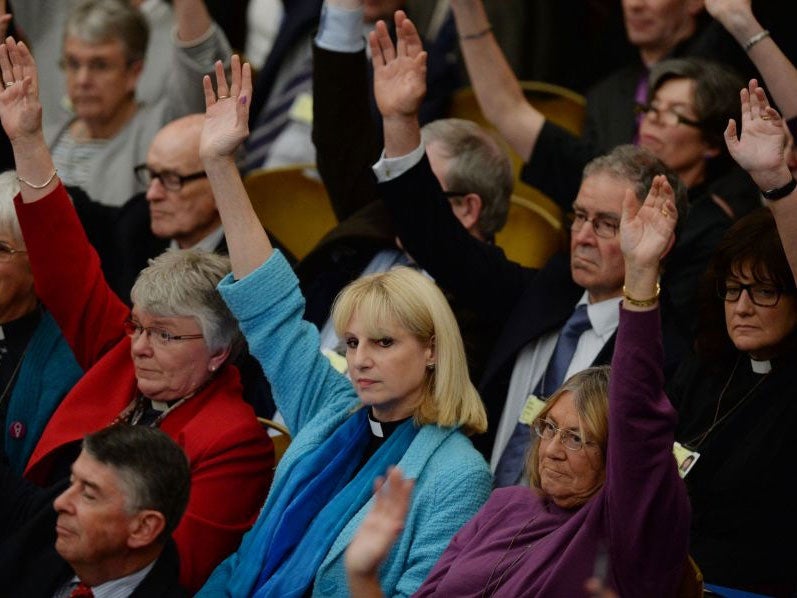Church of England shatters 'stained-glass ceiling' by allowing female bishops
The historic result comes after years of campaigning

Church of England leaders have swept away centuries of inequality by voting by an overwhelming majority to allow women to become bishops.
With a simple show of hands at its London meeting, the Anglican General Synod signed off legislation to change the wording of “Canon 33” to read: “a man or a woman may be consecrated to the office of bishop”.
After years of campaigning and intense internal dispute, women will now be able to take the highest office within the Church of England - some two decades after women were first ordained as priests. Now, women make up around a third of clergy.
In another example of its modernisation, the Church of England announced the change to its cannon on Twitter, as part of its #Synod live-blog.
Today's vote rubber-stamped legislation to introduce the first women bishops put forward in July.
The first female bishop is expected to take her seat next year. The Very Rev Dr Jane Hedges, 58, dean of Norwich, is the bookies' favourite to become the first woman bishop.
Ladbrokes has offered 3/1 for the former canon steward of Westminster Abbey and archdeacon of Westminster. She leads the Ven Rachel Treweek, archdeacon of Hackney (6/1), and the Very Rev Dr June Osborne, dean of Salisbury Cathedral (8/1).
Other leading candidates include the Very Rev Vivienne Faull, dean of York Minster.
Synod member Christina Rees, who has campaigned for equality in the institution for 25 years, said prior to the vote that she hoped that women would eventually make up a high proportion of senior roles.
She said it would change the public view that the church had a “problem with women” and said there was nothing stopping a female bishop being appointed straight away.
“The stained-glass ceiling is finally being shattered,” she added.
Speaking to reporters after the vote, Archbishop of Canterbury, the Most Rev Justin Welby, said: "It has taken a very, very long time and the way is now open to select people for the episcopacy, to nominate them on the basis simply of our sense that they are called by God to be in that position without qualification as to their gender."
He added: "We are working very, very hard on training and development of people, men and women, for senior posts in the church.
"The aim is...that you end up with a big pool of people where gender is irrelevant and that that pool is pretty evenly mixed.
"There is a very conscious effort to make it easy for Crown Nomination Commissions to be able to have a fair choice between men and women. And we are going to take this very very seriously," he declared.
Dean of York, The Very Reverend Vivienne Faull, who is a bookies' favourite to become the first woman bishop. (Getty)
Read more: Church of England to vote to allow female bishops
British values teaching plans are too narrow, says Church
Two per cent of Anglican priests don't believe in God, survey finds
Key dates in the process of introducing women bishops in the Church of England:
1975: General Synod votes that there is “no fundamental objection” to the ordination of women to the priesthood.
1978: A motion to bring forward legislation to remove the barriers to the ordination of women to the priesthood and their consecration as bishops fails at General Synod.
1985: General Synod votes to allow women to become deacons.
1987: First women deacons are ordained in the Church of England.
1992: General Synod votes to permit women to be ordained in the priesthood.
1994: 1,500 women deacons ordained as priests.
2005: A motion to begin the process of removing the legal obstacles to women as bishops is approved by the General Synod.
2011: 42 out of 44 dioceses approve draft legislation to introduce women bishops.
2012 The legislation fails narrowly at the General Synod by just six votes in the House of Laity.
2013: New talks get under way to introduce more simple legislation. Mediation and conflict resolution experts are called in to help opposing groups in the General Synod resolve their differences.
2014: General Synod asked for second time to give final approval to legislation introducing women bishops.
Additional reporting by Press Association
Join our commenting forum
Join thought-provoking conversations, follow other Independent readers and see their replies
Comments